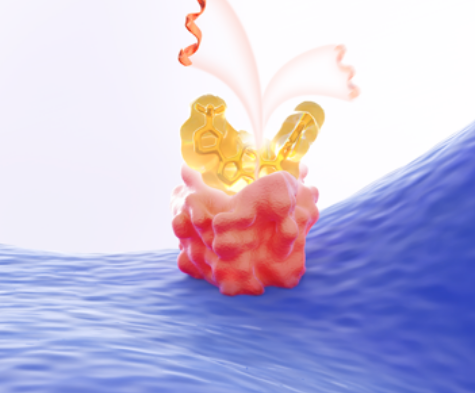VEOZAH is the first and only neurokinin 3 (NK3) receptor antagonist that blocks NKB from binding on KNDy neurons to help reduce heat signals that trigger VMS.1,3
THIS WEBSITE IS INTENDED FOR US HEALTHCARE PROFESSIONALS ONLY.
I certify that I am a healthcare professional in the US.
NOOffer your patients a different option to manage VMS with VEOZAH.1
EFFICACY AND SAFETY
VMS relief day and night
VEOZAH demonstrated statistically significant reductions from baseline in the frequency and severity of moderate to severe VMS over 24 hours compared to placebo, at weeks 4 and 12.1*
The efficacy of VEOZAH was studied in 1022 women who received 1 of 2 doses of VEOZAH (including 45 mg) in two 12-week, randomized, placebo-controlled, double-blind Phase 3 studies. In each of these 2 trials, after the first 12 weeks, women on placebo were rerandomized to VEOZAH for a 40-week extension to evaluate safety for up to 52 weeks total exposure.1
SAMPLES
Want to offer your patients VEOZAH?
Register to request VEOZAH samples for your practice in 3 easy steps:
Register
Visit VEOZAHsamples.com.Order
Once your credentials and signature have been verified, you can order product samples by your specialty.Receive
Samples can be delivered by your local Sales Representative or mailed directly to your office.
Recommended by The Menopause Society as a nonhormonal option for VMS3‡
‡ The Menopause Society (formerly NAMS) supports the use of and recommends several nonhormonal therapies for the treatment of VMS, including VEOZAH (fezolinetant), and maintains that hormone therapy (HT) is the most effective treatment for VMS, but not all women are candidates for HT due to contraindications or personal preference.3
‡ The Menopause Society (formerly NAMS) supports the use of and recommends several nonhormonal therapies for the treatment of VMS, including VEOZAH (fezolinetant), and maintains that hormone therapy (HT) is the most effective treatment for VMS, but not all women are candidates for HT due to contraindications or personal preference.3
IMPORTANT SAFETY INFORMATION
INDICATIONS AND USAGE

IMPORTANT SAFETY INFORMATION
INDICATIONS AND USAGE
CONTRAINDICATIONS
VEOZAH is contraindicated in women with any of the following:
- Known cirrhosis
- Severe renal impairment or end-stage renal disease
- Concomitant use with CYP1A2 inhibitors
VEOZAH™ (fezolinetant) is a neurokinin 3 (NK3) receptor antagonist indicated for the treatment of moderate to severe vasomotor symptoms due to menopause.
CONTRAINDICATIONS
VEOZAH is contraindicated in women with any of the following:
- Known cirrhosis
- Severe renal impairment or end-stage renal disease
- Concomitant use with CYP1A2 inhibitors
INDICATIONS AND USAGE
VEOZAH™ (fezolinetant) is a neurokinin 3 (NK3) receptor antagonist indicated for the treatment of moderate to severe vasomotor symptoms due to menopause.
WARNINGS AND PRECAUTIONS
Hepatic Transaminase Elevation and Hepatotoxicity
In 3 clinical trials, elevations in serum transaminase [alanine aminotransferase (ALT) and/or aspartate aminotransferase (AST)] levels > 3x the upper limit of normal (ULN) occurred in 2.3% of women receiving VEOZAH and 0.9% of women receiving placebo. No elevations in serum total bilirubin (> 2x ULN) occurred. Women with ALT or AST elevations were generally asymptomatic. Transaminase levels returned to pretreatment levels (or close to these) without sequelae with dose continuation, and upon dose interruption, or discontinuation. Women with cirrhosis were not studied.
In the postmarketing setting, a case of acute mixed hepatocellular cholestatic drug-induced liver injury with elevations of ALT, AST, alkaline phosphatase (ALP), and total bilirubin with symptoms of fatigue, nausea, pruritus, jaundice, pale feces, and dark urine occurred in a woman receiving VEOZAH. The individual’s signs and symptoms gradually resolved after discontinuation of the drug.
Perform baseline hepatic laboratory tests to evaluate for hepatic function and injury [including serum ALT, serum AST, serum ALP, and serum bilirubin (total and direct)] prior to VEOZAH initiation. Do not start VEOZAH if the concentration of ALT or AST is ≥ 2x ULN or if the total bilirubin is elevated (e.g., ≥ 2x ULN) for the evaluating laboratory. If baseline hepatic transaminase evaluation is < 2x ULN and the total bilirubin is normal, VEOZAH can be started.
Perform follow-up hepatic laboratory tests monthly for the first 3 months, at 6 months, and 9 months after initiation of therapy.
Advise patients to discontinue VEOZAH immediately and seek medical attention including hepatic laboratory tests if they experience signs or symptoms that may suggest liver injury: New onset fatigue, nausea, vomiting, pruritus, jaundice, pale feces, dark urine, or upper right quadrant pain.
Discontinue VEOZAH if:
- Transaminase elevations are > 5x ULN
- Transaminase elevations are > 3x ULN and the total bilirubin level is > 2x ULN
If transaminase elevations > 3x ULN occur, perform more frequent follow-up hepatic laboratory tests until resolution.
Exclude alternative causes of hepatic laboratory test elevations.
ADVERSE REACTIONS
The most common adverse reactions with VEOZAH ≥ 2% and > placebo (VEOZAH % vs. placebo %) are: abdominal pain (4.3% vs. 2.1%), diarrhea (3.9% vs. 2.6%), insomnia (3.9% vs. 1.8%), back pain (3.0% vs. 2.1%), hot flush (2.5% vs. 1.6%), and hepatic transaminase elevation (2.3% vs. 0.8%).
Please click here for full Prescribing Information for VEOZAH (fezolinetant).
REFERENCES: 1. VEOZAH [package insert]. Northbrook, IL: Astellas Pharma US, Inc. 2. Thurston RC. Vasomotor symptoms. In: Crandall CJ, Bachman GA, Faubion SS, et al., eds. Menopause Practice: A Clinician’s Guide. 6th ed. Pepper Pike, OH: The North American Menopause Society, 2019:43-55. 3. The North American Menopause Society. The 2023 nonhormone therapy position statement of the North American Menopause Society. Menopause 2023;30(6):573-90.







